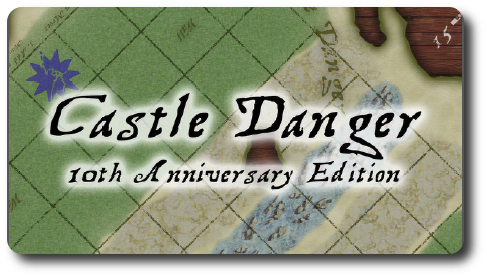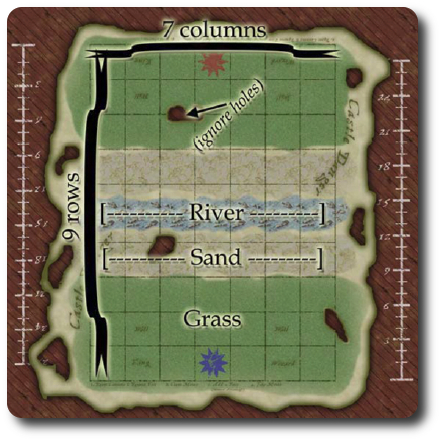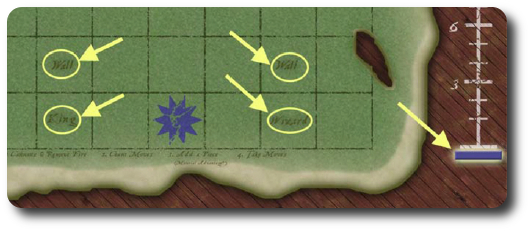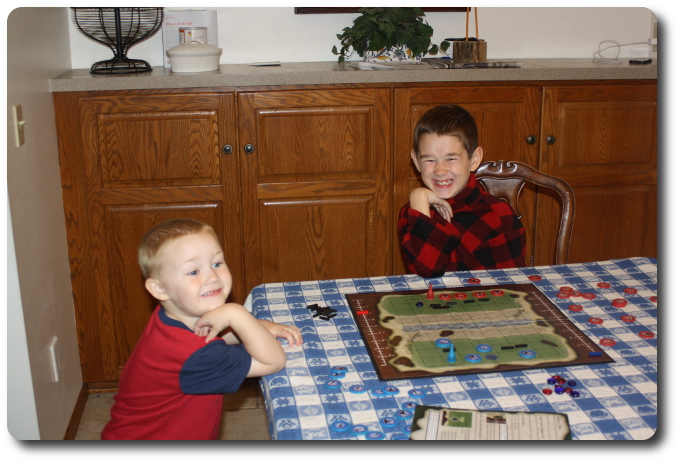
The Basics:
- For ages 5 and up (publisher suggests 12+)
- For 2 players
- Approximately 45 minutes to complete
Geek Skills:
- Counting & Math
- Logical & Critical Decision Making
- Strategy & Tactics
- Risk vs. Reward
- Hand/Resource Management
- Worker Placement & Area Control
Learning Curve:
- Child – Easy
- Adult – Easy
Theme & Narrative:
- In this abstract game of warfare, keep your King free and clear of the cannonballs!
Endorsements:
- Gamer Geek mixed!
- Parent Geek approved!
- Child Geek approved!
Overview
In this abstract game of strategy, players must move and defend at the same time. Walls must be constructed to protect and sometimes demolished to advance. Cannonballs can target seemingly unreachable units that are a long way off from the battle line, and the limits of space will require players to consider the value of each of their pieces. In the end, the player who can balance and optimize the fastest will win the war!
Castle Danger, designed by Matt Worden and published by Matt Worden Games, is comprised of 1 game board, 20 Wall pieces, 2 King pawns (1 red, 1 blue), 16 Wizard tokens (8 red, 8 blue), 6 Builder tokens (3 red, 3 blue), 10 Cannon tokens (5 red, 5 blue), 10 Cannon “Fired” tokens (5 red, 5 blue), 10 Fire markers (5 red, 5 blue), and 2 Move Tracker pieces (1 red, 1 blue). This is a review of a special release of the game, which includes updated components. Castle Danger has seen no less than 5 different editions since its first release in 2003.
Game Set Up
To set up the game, first unfold the game board. Orientate the game board so that the “River” splits the playing area in half. Players should now be seated behind the star burst icons located on the ends of the game board.

Second, have each player take all the game pieces that match the color of the star burst that is closest to them (will be either red or blue). In total, each player will collect 1 King pawn, 8 Wizard tokens, 3 Builder tokens, 5 Cannon tokens, 5 Cannon “Fired” tokens, 5 glass Fire markers, and 1 Move Tracker piece. The black Wall pieces should be placed to one side of the game playing area and within easy reach of all the players.
Third, each player now places their Move Tracker piece on the bottom of the numbered track that is to their right (each player will have their own track). This track will help the player count how many moves they have in total and how many they have left during their turn.
Fourth, each player will now place their King pawn, 1 Wizard token, and 2 Wall pieces onto the starting positions noted on their side of the game board. All other pieces will remain off to the side of the game board at this time until used by their owning player.

That’s it for game set up! The player who has the blue pieces traditionally goes first. TO WAR!
Know Your Army
Castle Danger is a 2-player abstract combat game. The game pieces represent specific combatants out in the field that the players will command and the wall obstacles they will need to build or destroy. Knowing what each game piece is and does is essential to a player’s success. Well, that and strategic thinking. In some ways, Castle Danger is like Chess and will require the players to move their game pieces into position for attacks. Luck plays no part in this game. Every victory and defeat is based on the sharpness of a player’s wit, skill, and guile.
The King
The King is the single most important piece in the game and the least effective in combat. The King is a target and nothing more. As long as the King remains in the field, the troops will rally and fight on. The moment the King falls, the battle is over.
The Wizards
The Wizards are students of the mystical arts, but their formidable magics are focused only on ensuring the King’s army moves as swiftly as possible. These are not the type of spellweavers that shoot flaming fireballs into the air or cast lighting bolts of pure hot death. Rather, these Wizards have learned how to bend space and time. Through their arcane might, the King’s army can accomplish more in a single day than it would take an entire legion to complete in a week.
The Builders
The Builders are combat craftsman. They pride themselves in being able to build sturdy structures quickly when under fire. It’s been said that the only way to stop a Builder in the thick of battle when they are surrounded by swords and death is to simply let them finishing hammering.
The Cannons
Giant hulking metal beasts that belch fire and destruction, the Cannons are true technical marvels and the stuff of nightmares. Able to fire at foes from long distances and scorch the earth, the sound of the Cannons are thought by many to be the thunderclap of doom.
O war! Thou Son of Hell…
The game is played in turns with no set number of turns in a single game. A player’s turn is comprised of 5 steps which we will summarize here.
Step 1: Resetting Cannons and Removing Fires
If this is the player’s first turn, they can skip this step. Otherwise, this step allows the player to remove all Cannon “Fired” tokens currently on their Cannons and remove any glass Fire markers of the player’s color from the game board. These game pieces are set aside until required again.
Step 2: Count Moves
By default, a player is given 3 moves per turn. But for every Wizard the player has on their side of the game board, they are awarded 3 additional moves. For example, a player with 2 Wizards on the game board would have a total of 9 moves on their turn. The Move Tracker piece is then placed so it shows how many total moves the player has. As the player takes moves, they will adjust the position of the Move Tracker so it counts down until the player has used all their moves or ends their turn.
Step 3: Add Game Pieces
Wizards, Builders, and Cannons enter the game on a specific square referred to as “the portal”. This is the colored star burst that is the closest to the player. If no other game piece currently occupies the portal, the player can place a Wizard, Builder, or Cannon token. If the player has fewer game pieces on the battlefield than their opponent, it cost nothing to introduce new combatants. However, if the player has the same or more than their opponent, it will cost the player 2 moves. When counting game pieces, only add the total number of Wizards, Builders, and Cannons in play.
Step 4: Move
On a player’s turn, they can take all, some, or none of their moves. Any of the following moves can be made and in any order. Before the player takes one of the following moves, they should check to see if they have enough moves left (as identified by the current position of the Move Tracker piece on the game board’s Move track) and then adjust their Move Tracker piece accordingly afterward.
Move a Game Piece
At the cost of 1 move, the player can slide their King, a Wizard, a Builder, or a Cannon to an empty adjacent square. Diagonal movement is not allowed. The middle 2 rows are impassable and no game piece may enter them. This leaves each player a 4 x 7 grid in which to manuever their army.
Add a Wall
For 1 move, the player can place 1 Wall piece to any empty “Grass” space on the game board that is adjacent to a player’s Builder. Walls can never be built on sand or in the rushing waters of the river. When a Wall is built, it should be placed in the middle of the adjacent square, not on one of its edges. Walls block game piece movement, but provide shelter from cannon fire.
Remove a Wall
For 1 move, the player can remove a Wall piece that is adjacent to one of their Builders.
Fire a Cannon
The player can target any square in their opponent’s territory that is in the same column as the Cannon token being fired. For every square the cannonball will travel through, it will cost the player 1 move. The squares that cross the river and the sand are counted when determining the total distance. Cannonballs cannot travel over Wall pieces but can travel over other game pieces. When the cannonball strikes its target, the game piece is removed from the game board and replaced with a glass Fire marker. This spot cannot be moved into or through by the player’s opponent. Note that an opponent’s portal cannot catch fire. Any game pieces struck by the cannonball are destroyed, but the fire instantly goes out when it touches the portal.
Once a Cannon is fired, the player will place a Cannon “Fired” token on top of it to show that it cannot be fired again this turn. The Cannon can continue to be moved, however.
Step 5: Ending of Turn
The player’s turn ends when the have used all their moves or determine they are done, regardless of how many moves they might have left. Note that moves cannot be “banked” from one turn to the next. If moves are not use, they are lost. This ends the player’s turn and it’s now their opponent’s turn.
The King is Dead
The game can end in two different ways. The first is if a player’s King is successfully targeted and shot by a cannonball. If a player loses their King, they lose the game. The second only occurs if both sides decide the game is a stalemate. In which case, the sane thing to do is to call it quits.
Game Variants
Castle Danger can be played in a tournament style format with little effort. Included in the rules are instructions on how a tournament organizer should bracket the games and how game length can be capped by reducing the total turns to 30.
While not a game variant in the truest sense of the term, Castle Danger can be played for free online. It’s available at Your Turn, My Turn and Super Duper Games.
To learn more about Castle Danger, visit the game’s web page.
Prediction
Chess and Checkers have always had a place in my home and on my family gaming table. I am a fan of these classic games and view them as mandatory primers for my children’s geek upbringing. They are solid, provide an excellent foundation for other games, and make player’s think on an abstract level that strengthens the creative and logical thinking process.
They can also be really boring. That is why I always jump at the chance to play games that are somewhat like the classics, but put a fresh new spin on it. For example, Dragon Face, Crowns, and ZombieZone. These three games take elements of Chess and Checkers and blend them into something new. It also helps that there is a bit more theme and narrative coated over it. This makes it easier for a player to grasp the concept of the game and make the abstract a bit more concrete. Depending on the type of player, even the slightest concrete mental handhold can make all the difference between being totally lost and “getting the game”.
And to be clear, Castle Danger is very abstract. It does, however, have some concrete game choices. For example, building walls is something everyone’s mind can wrap around. Build a wall and duck behind it. Simple. The same goes for cannons firing bloody huge balls of fire. With just enough concrete elements shuffled into the abstract game play, the moves a player makes and the choices they must ponder become just a bit easier to internalize.
But will it be enough and does it suggest the game will be any fun? For the Child and the Parent Geeks, I think the answer is an absolute “yes”. As a 2-player game, it’s well within the grasp of young and even non-gamers. Castle Danger is light, plays fairly quickly, and there is just enough player choice to make each move interesting and important. I don’t foresee much in the way of mental fatigue or vapor lock. There is also a great deal of room for strategy and tactics, which is always a plus. Of course, without the element of luck in the game, the deciding factor that determines the game’s winner will be player experience. A stronger player will always win, which is not a bad thing, but it can be very upsetting to younger players who will quickly become disgruntled when they can’t claim a single victory.
For the Gamer Geeks, I am not totally certain. While I do consider Castle Danger a game that requires strategy and tactics to win, I am concerned that the Gamer Geeks will see it as nothing more than a series of limited moves that allow the players to jockey back and forth. That doesn’t sound all the interesting, and games that are not interesting hardly ever get the thumbs up approval from the elitists.
Teaching Castle Danger should be done in the same way you’d teach a new player Chess or Checkers. I suggest you introduce each of the game pieces one at a time and detail what they can and cannot do. I would then go through a single turn as an example to demonstrate how quickly the moves will be used. I also strongly suggest you make it a point to state that game pieces cannot travel through each other. I got in trouble with one player because they didn’t understand this simple fact. Feelings were hurt and the game was reset as a result. In some cases, it’s better to give too much info, even at risk of overwhelming a new player. If nothing else, they’ll have the rule in the back of their mind, even if they don’t immediately recall it.
Teaching the game to my two oldest little geeks was very simple. They are both already familiar with Chess and Checkers, and had no problem quickly grasping what the different game pieces did. The only question I had from them was game piece elimination. There is nothing in the rules that suggests that a game piece is forever gone when it’s destroyed via a cannonball. It simply goes off the board and can reappear if the player wants to pay for it. They both liked this a great deal and were eager to play. But before we did, I asked them both what they thought of Castle Danger so far.
“I really like how all our movement is based on points. This make the Wizard really important, but the game piece takes up much-needed space.” ~ Liam (age 8)
“I really like the cannons, Daddy!” ~ Nyhus (age 5)
Wow. Mind. Blown. My 8-year-old saw something I failed to really recognize when I was learning the game. He is, of course, correct. The Wizard is essential to gaining moves. The more moves a player has, the more they can do on their turn. But, clearly, there is a tipping point where lots of Wizards on the board fails to give the player a solid return. Boy, talk about a proud parent moment! Let’s play Castle Danger and see if Matt Worden has once again created a game we very much enjoy or Castle Danger should be forgotten.
Final Word
For the Child Geeks, Castle Danger is going to appeal to those players who enjoy abstract games already and do not get easily frustrated. I wouldn’t go so far as to say that Castle Danger requires the player to have solid emotional coping skills, but there were several times during the game where a younger player became exceeding frustrated. The reason was easy to spot. The younger Child Geeks failed to recognize the number of movements they had as a resource and squandered them as a result. It also became apparent that some of the Child Geeks overkilled their Wizards, thinking that they were the key to victory. This is not the case, however. A player who has a lot of Wizards simply has more targets that can be hit and more potential actions. Neither of these two things resolve to a victory, however. Overall, the Child Geeks enjoyed themselves, and it was clear that all the Child Geeks we taught knew how to play the game. Like most games, however, the player with more experience always dominated. This makes Castle Danger a game that the younger Child Geeks seldom wanted to play with more mature players. When they played it within their peer and experience group, the game did very well. The majority of the Child Geeks had a good time and voted to approve Castle Danger. Just be aware that the younger and less experienced players voted it down because they weren’t having fun constantly losing.

One last game before my little geeks go to bed!
The Parent Geeks, especially those who enjoyed abstract games, found Castle Danger to be an excellent time and an entertaining 2-player experience. None of the Parent Geeks thought the game had much in the way of theme and most were confused about the strange mix of fantasy and military game pieces. It all works, mind you, but some Parent Geeks can be very picky when it comes to games “making sense”. Once they got past the idea that a “Wizard” was just the name of the game piece (and did not suggest that actual magic or spells were available in the game), they started to come around. Only one non-gamer Parent Geek flat-out rejected Castle Danger calling it, “A boring game that makes no sense or provides any fun.” I should note that this particular player never won a single game and their criticism might be forged from the red-hot flames of exasperation. All the other Parent Geeks enjoyed their time with Castle Danger and some even thought it a better alternative to (if not a solid replacement of) traditional Chess and Checkers.
All the Gamer Geeks recognized Castle Danger as an abstract strategy game and identified that the game did require a significant level of strategy and tactics. What Castle Danger lacked, however, was much in the way of appeal. According to one Gamer Geek, “Another solid game from a solid game designer, but I don’t find this particular game to be of much interest.” Another Gamer Geek suggested, “The game is fine, but it feels too much like Chess and too little like something new.” Perhaps Castle Danger is showing its age? Possible, but I think this comes down to player engagement. None of the Gamer Geeks felt overly enthralled with their game playing experience. To be clear, none of the Gamer Geeks thought that Castle Danger was a bad game, but they were very mixed when it came to its overall level of endorsement. Some wanted to approve it based on its solid game play and some wanted to reject it because they felt the game was not doing anything of real interest (which is a highly objective statement).
Personally, I could take or leave Castle Danger at this point. It plays well enough, but fails to overly excite me. The level of complexity is based and deeply rooted to a player’s opponent, and I haven’t played with many people who have challenged me. I’m not bragging, mind you, but I think most of my lack of having strong feelings for or against the game is due to not feeling challenged. Perhaps my feelings towards Castle Danger will shift in the future, but until then I’ll be keeping the game because my little geeks enjoy playing it. For me, that’s often times enough to make room for a game on my shelves. And who knows? Perhaps my little geeks will one day be better at the game than me and I’ll finally have a challenging adversary. Which is exactly what I hope to get.
If you are looking for alternatives to Chess or Checkers, or simply looking for a new abstract game to play with two players, do take a look at Castle Danger.
This game was given to Father Geek as a review copy. Father Geek was not paid, bribed, wined, dined, or threatened in vain hopes of influencing this review. Such is the statuesque and legendary integrity of Father Geek.



